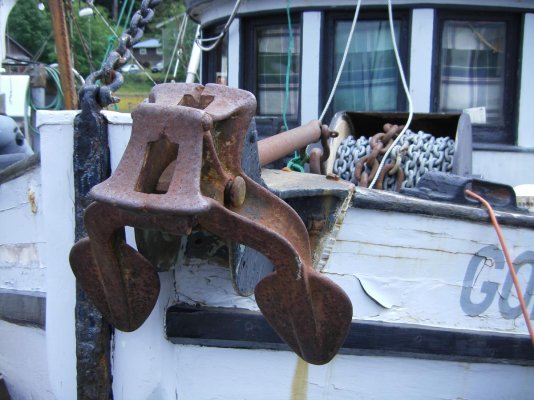We have a big stainless steel split "hoop" that you put around a chain (or rope) and then attach a shackle to. You can then put a kellet and control line on the shackle and send the hoop down the chain however far you want under the weight of the kellet. The hoop is large enough that it slides very easily over even big chain with no problems.
In fact the hoop is large enough to slide down a rode and on over the shank of most anchors. So you can get round the other side of the anchor and pull the hoop to the fluke end of the shank and then back the anchor out. We prefer to use a trip line shackled directly to the wide end of the fluke but we carry the stainless hoop as a Plan B. So far we've never used it, either to hold and position a kellet or back an anchor out.
And Eric, if the guy who designed the wing on the 787--- and it was one guy who did this--- wrote an article about the advancements of wing design using the 787 wing as his example would you discount what he said because he works for Boeing and so has a vested interest in the 787's success?
Peter Smith is no different. He came up with an anchor design that has proved outstanding in service all over the world. And yes, he utilized some ideas that had been proven in other earlier designs and admits this, just as our wing designer used elements of earlier wing designs in his 787 wing and says so.
But the point is that most people who develop new designs for anchors, wings, automotive components, railroad locomotive propulsion systems, you name it, are not doing this in a vacuum. They almost always work for a company or are in the business of making and selling the products they have developed. It's usually the only way the costs of the research and development can be covered.
Are you going to discount the validity of everyone who has proven to be an expert in their field because they work for the company that builds or utilizes their designs, or they build and market the product they designed?
I would find that a very limiting attitude as it would cut me off from benefiting from most of the innovators in this world.
Regardless of what Peter Smith is like as a person--- and I have never met or talked to him so I don't know what he's like--- I think there is no denying he has put a lot of thought into his anchor design and has created a real winner. And he has a ton of real-world boating and anchoring experience in some of the toughest waters in the world--- the southwestern Pacific. So I think he knows whereof he speaks. To discount or dismiss what he says because he's basing it on what he's learned from his experience creating and using an anchor of his own design is, I think, a mistake.
In fact the hoop is large enough to slide down a rode and on over the shank of most anchors. So you can get round the other side of the anchor and pull the hoop to the fluke end of the shank and then back the anchor out. We prefer to use a trip line shackled directly to the wide end of the fluke but we carry the stainless hoop as a Plan B. So far we've never used it, either to hold and position a kellet or back an anchor out.
And Eric, if the guy who designed the wing on the 787--- and it was one guy who did this--- wrote an article about the advancements of wing design using the 787 wing as his example would you discount what he said because he works for Boeing and so has a vested interest in the 787's success?
Peter Smith is no different. He came up with an anchor design that has proved outstanding in service all over the world. And yes, he utilized some ideas that had been proven in other earlier designs and admits this, just as our wing designer used elements of earlier wing designs in his 787 wing and says so.
But the point is that most people who develop new designs for anchors, wings, automotive components, railroad locomotive propulsion systems, you name it, are not doing this in a vacuum. They almost always work for a company or are in the business of making and selling the products they have developed. It's usually the only way the costs of the research and development can be covered.
Are you going to discount the validity of everyone who has proven to be an expert in their field because they work for the company that builds or utilizes their designs, or they build and market the product they designed?
I would find that a very limiting attitude as it would cut me off from benefiting from most of the innovators in this world.
Regardless of what Peter Smith is like as a person--- and I have never met or talked to him so I don't know what he's like--- I think there is no denying he has put a lot of thought into his anchor design and has created a real winner. And he has a ton of real-world boating and anchoring experience in some of the toughest waters in the world--- the southwestern Pacific. So I think he knows whereof he speaks. To discount or dismiss what he says because he's basing it on what he's learned from his experience creating and using an anchor of his own design is, I think, a mistake.
Last edited:




 This is exactly what I was referring to in my post about deck mounted drum winches.
This is exactly what I was referring to in my post about deck mounted drum winches.